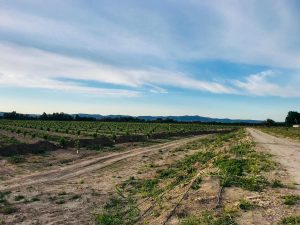
Pecan Production in Europe
Once a small, regional crop within the southern United States, pecans are now a globally marketed and, indeed, a globally produced crop. Pecans are produced in significant volume in the United States, Mexico, South Africa, Brazil, Argentina, Uruguay, Chile, Peru, Australia, and China. The pecan industry is also being developed in European countries, with commercial...
Read more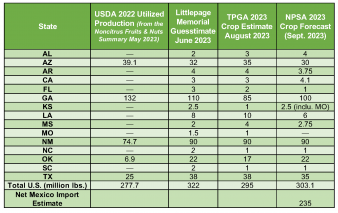
The Problem with Crop Estimates
For years, the U.S. pecan industry has based its annual expectations on crop “estimates,” which have been used to determine how large or small the crop may be. These estimates, in turn, have historically gone a long way toward determining the price growers receive for that season’s crop. The calculation of these estimates is inherently...
Read more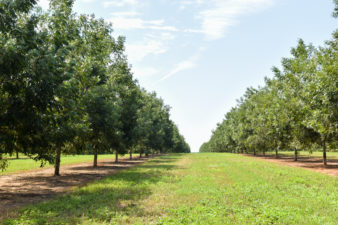
The Pecan Tree in September
Over time, the best growers learn, in many ways, to think like a pecan tree. If you want to know what to provide to the trees and when to get optimal performance and production from them, you have to understand what is going on inside the pecan tree at various critical times throughout the growing...
Read more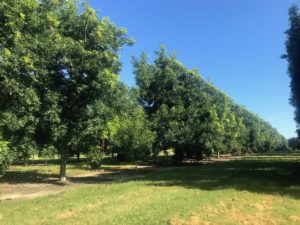
Summer Tasks to Consider in the Pecan Orchard
June can be an exciting time in the orchard. The pecans begin to size, and you’re in the heat of the struggle to make and protect the crop and busy with most any task imaginable in the orchard—applying fungicide, mowing, fertilizing, scouting, spraying for certain insects, spraying weeds, the list goes on. Here are a...
Read more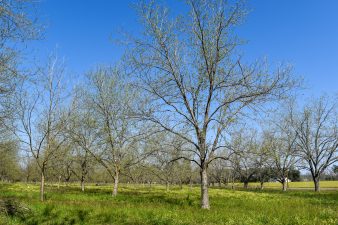
Budbreak Sets the Clock for the Pecan Season
A new pecan season is upon us. For the grower, this means anticipation of what this year’s crop may bring. Will the trees set a good crop of nuts? Will crop maturity and harvest be ahead or behind schedule? At this point, these secrets remain hidden within the trees and will begin to be revealed...
Read more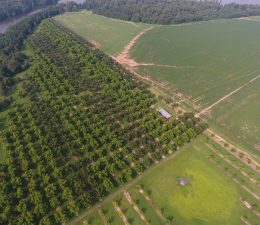
Pecan Orchards Improve Soil Quality
Consumers are increasingly concerned about the environmental impacts of food production. In many ways, pecans have more to offer consumers besides a healthy, great-tasting product. Pecans are native to North America. They are a long-lived, perennial crop. Their long lifespan keeps a lot of carbon locked up in the tissues of pecan trees for an...
Read moreWater can be a blessing and curse for pecans in July
We will be well into the nut sizing period here in Georgia by the time you read this article, and water will play a critical role in several ways. For one, rainfall is good for soil moisture, which is the primary factor involved in sizing the pecans. On the other hand, rainfall can be a...
Read more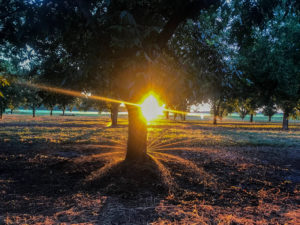
Thinking like a pecan tree
Sometimes when you’re out in the orchard and you listen closely amid the bird song, you can hear the leaves rubbing edges in the breeze, busy at their work of changing sunlight to sugar with a little help from the roots pulling water and nutrients from the soil. You’ll have to switch off the tractor...
Read more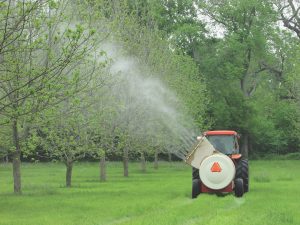
Rising fertilizer costs require attention to inputs
There is an old saying that you have to spend money to make money. This is certainly true when it comes to growing pecans, but there is a fine line between spending money to make money and spending money to lose money. That line becomes even thinner at the current cost of fertilizer and chemicals....
Read more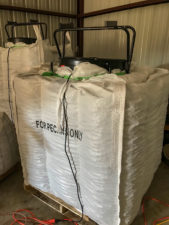
Protecting pecan quality through and beyond harvest
Harvest has arrived, and all the tasks that go into growing and protecting the crop have come to a close—at least for the next two or three months. At this point, it’s all about putting nuts in the wagon. But, for the Southeastern grower, harvest brings with it a new set of worries to consider....
Read more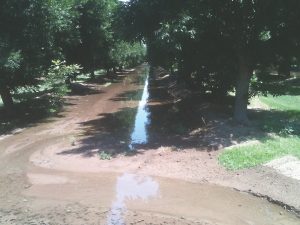
Late-season water demand: how much is enough?
Pecans are considered a high water-use crop, and pecan’s water demand peaks during the kernel filling stage, which occurs from mid-August through mid-September. In Georgia, we recommend 3,600 to 4,000 gallons per acre per day for trees bearing a commercial crop during this critical period. We are fortunate in the Southeast that rainfall contributes to...
Read more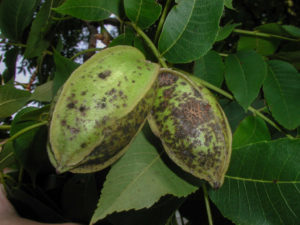
Your fungicide spray program can fight pecan scab and decrease production costs
Here in the southeastern United States, we commonly grow over 20 different pecan cultivars. These vary considerably from each other in any number of ways—size, shape, kernel percentage, shell-out potential, precocity, time of harvest, insect preference, and most notably for this article, pecan scab susceptibility. Since these cultivars vary so widely in their scab susceptibility,...
Read more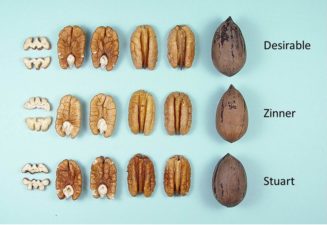
New Pecan Varieties to Consider When Planting
The age-old question for pecan growers is “What variety should I plant?” We have a lot of options in the Southeast. And truthfully, there is no single answer out there that will be suitable for everyone. Every cultivar has its good and bad points. The real question you need to ask yourself is “What am...
Read more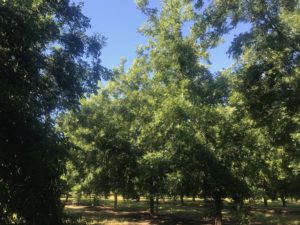
Make the Most of Hedge Pruning in the Southeast
While the 2020 pecan crop was good from a volume standpoint in Georgia and much of the Southeast for those areas spared the brunt of hurricane damage, most growers have not been able to sell much of their crop at a profitable price so far this harvest season. According to USDA NASS and AMS pricing...
Read more
5 Late-Season Tips for Your Pecan Crop
We are now in the home stretch for the 2020 pecan growing season. Hopefully, at this point, you have done what was required to grow and protect a good crop. But it’s not over quite yet. There are still a few things left to consider as we move into September in order to get the...
Read more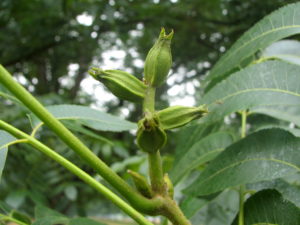
After the June Drop, protecting your remaining pecans
So far, as I write this, it looks as though the female flower bloom in Georgia is one of the best we’ve had in quite a while. This bloom is very encouraging and somewhat expected, going into our second growing season following a major hurricane. The response of trees in other previously hard-hit areas along...
Read more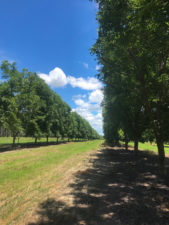
Growing Pecans for Today’s Market
We’re still trying to rebuild in much of Georgia’s pecan production region after the destruction caused by Hurricane Michael and the issues caused by the tariffs imposed last year on pecans. Growers are rehabbing their orchards and replanting pecan trees. Some orchards have been cleared and completely renovated with new plantings. And surprisingly, I am...
Read more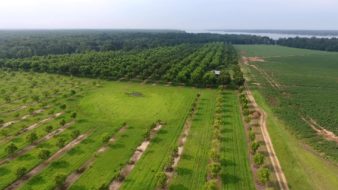
What Are a Pecan Orchard’s Ecosystem Services?
A recent report from the Intergovernmental Panel on Climate Change (IPCC) suggested agriculture held part of the answer to climate change. Farmers often meet climate change with skepticism, but before you label me as a fruitcake for bringing this up, hear me out. I’m not here to judge or sway your opinion on climate change....
Read moreGeorgia Pecan Industry Loses One of its Champions
Before I was hired as the Pecan Extension Specialist for the University of Georgia, I worked for about three years or so as the Extension Agent in Dougherty County, Georgia. It can be difficult for new agents to break the ice with farmers, especially pecan farmers, and especially in a county where, for many years,...
Read more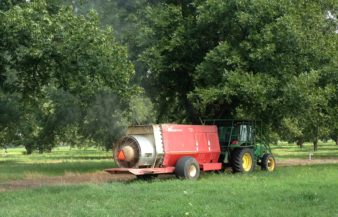
How to Get the Most Out of Your Fungicides
In the midst of a big turn-down in the pecan market, growers need to cut costs to make up some of the loss in profit potential. The problem is there are only so many things you can do. Crop load determines how much nitrogen you need to apply, so you can only cut corners there...
Read more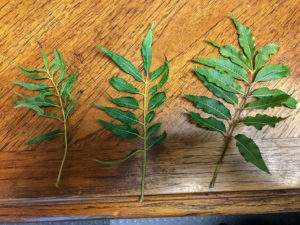
Handling Herbicide Drift in Pecan Orchards
Southeastern pecan orchards are often found growing adjacent to fields of annual row-crops. As a result, the tree canopies of these orchards are often vulnerable to injury from herbicide drift from the adjacent row crop fields. This normally occurs from April through June as weeds are eliminated from fields in preparation for planting or soon...
Read moreDifficult Pruning Decisions for Storm Recovery
The cleanup from Hurricane Michael is on-going here in Georgia and many growers have reached the point where they have a lot of the debris cleaned out of the way but have to decide what to do with mangled trees that remain standing. The answer will depend on a number of factors, including tree density...
Read more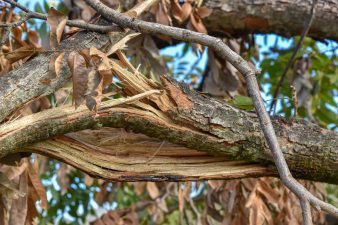
Trying Again After the Storm
By now, everyone is familiar with the havoc wrought by Hurricane Michael on the Georgia pecan industry back in October. Half the Georgia crop was lost along with over 740,000 trees, resulting in a loss equivalent to approximately 17 percent of Georgia’s pecan acreage and an estimated total of $560 million in losses to the...
Read more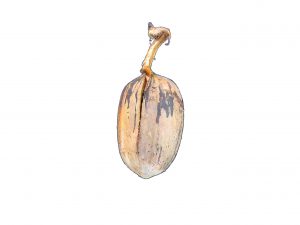
Beware of Late Season Issues Resulting from Inadequate Irrigation
We are nearing the end of the 2018 growing season but still have some issues to be concerned with. The relatively large ‘Stuart’ crop brings to my mind some issues that we almost always see when ‘Stuart’ trees are heavily loaded, but they are also issues that growers tend to forget about until they show...
Read more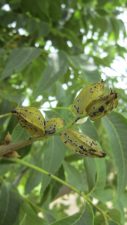
Scab Battle Heats Up, Watch for These 3 Factors
Planting resistant cultivars, planting on elevated land, and improving the orchard’s airflow are three key factors in managing pecan scab. However, for existing orchards, it is too late at this point in the season to do much about these variables. So, we are left with the most direct line of defense—fungicide application. Regarding this route...
Read more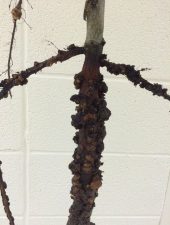
Pecan Root Knot Nematode: A Hidden Problem
Certain problems you encounter in growing pecan trees have characteristic symptoms and have been such obvious problems through the years that they have been studied extensively and have well-defined methods of treatment. Pecan scab, mouse ear, and zinc deficiency would fall into this category. But sometimes pecan trees may suffer from less obvious symptoms, and...
Read morePruning: A Proven Planting Method
The tree-planting trend continues here in the Southeast. I don’t know of a single nursery in Georgia that has trees available for planting now unless you booked way in advance, and many nurseries are rapidly booking up for the 2019 crop as well. So, with all the trees being planted and with the damage growers...
Read moreTwo Months Post-Irma, We’re Still Learning
Back in September, Georgia pecan growers got to experience what it would be like to grow pecans on the Gulf Coast. Hurricane Irma followed Interstate 75 directly up the Florida peninsula into Georgia with sustained winds of 20-40 mph and gusts reaching from 50-75 mph, something our friends in Alabama, Mississippi, and Louisiana are all...
Read more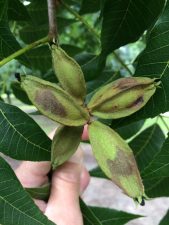
Production Problems Arise as Effects of Warm Winter Linger Throughout Growing Season
Warm winters like we had over the winter of 2016-2017 can cause a variety of issues for pecans, many of which may not become obvious until the season progresses. I have been concerned about this since bud break, and we have seen some of these issues come to pass. Hopefully as the season goes on,...
Read moreIrrigation and Fertilization of Young Pecan Trees
Most pecan growers are understandably eager to get young pecan trees into production. Aside from weed control, the two most important factors in doing this are irrigation and fertilization. Until recently there were no research-based recommendations for these two very important requirements. Before I get into these two topics, a word about site selection. The...
Read moreWhat Should You Do About Low Soil pH in the Herbicide Strip?
Fertilization of mature pecan orchards by application of dry nitrogen (N) fertilizer to the herbicide strip (known as broadcast banding) can help reduce fertilizer costs and the amount of wasted N fertilizer being applied to pecan orchards by eliminating the fertilizer that was applied to the grassed middles. However, a number of growers have continued...
Read more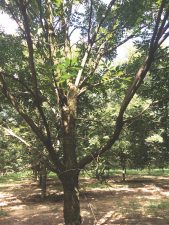
How Close Should Tree Spacing Get in The Southeast?
Pecans need two main things to grow and be productive: water and sunlight. Everything else is secondary. It’s been proven time and time again. Take care of these two things and everything else gets much easier. Since we have access to good water and most orchards are now well irrigated, sunlight becomes the most limiting...
Read moreWill rising pecan acreage cause the sky to fall?
I can’t tell you how many times I have been asked about or heard someone comment on the great potential for the pecan market to bottom out a few years down the road thanks to all the new acreage being planted. Make no mistake, anything that goes up is bound to come down at some...
Read more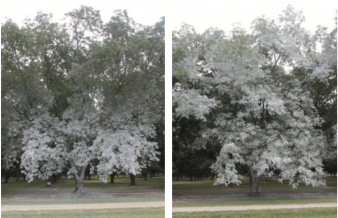
Scab Management Keys: Sprayer coverage, orchard environment
As we descend into another spraying season, keep the following in mind. If you have problems with scab control, the least likely factor will be the efficacy of the fungicide you are using. Unfortunately, this is often the first thing most growers try to pin the blame on. Aside from the obvious issues of rainfall...
Read moreLeaf Scorching of Young Pecan Trees, Part 2
Back in the November issue of Pecan South, I began a discussion on leaf scorching in young pecan trees. We’ve seen a lot of it lately and I believe most of what we are seeing is a cultural management issue involving difficulty with root establishment, particularly in intensively managed operations where the trees are pushed...
Read moreLeaf Scorching of Young Pecan Trees, Part 1
There is a myriad of things that can cause leaf scorch on a young pecan tree including drought, water-logging, nutritional deficiencies, fertilizer burn, herbicide injury, bacterial leaf scorch, nematodes, anthracnose and other minor foliar diseases, etc. It can be and often is difficult in many cases to sort out the problem. Isolated incidents are usually...
Read moreDon’t Underestimate Value of Airflow, Elevation in Scab Management
Fungicides do most of the heavy lifting regarding scab control and we often tend to focus all of our attention on fungicide selection when battling scab. But, there are many more factors that go into protecting a crop from disease. Coverage, for example, is vitally important. If you don’t cover the nuts with fungicide, you...
Read moreHow much fertilizer do young pecan trees need?
Root dry weight typically comprises 55-70 percent of total tree dry weight one year following transplant, which suggests that pecan tree transplants direct most of their resources to root establishment in the first growing season in the orchard. Pecan trees in the first two to three years of establishment have a limited root system compared...
Read moreCultivar Selection and Row Spacing: Science or Informed Opinion?
Over 100 years into commercial pecan production, we often still see more opinions regarding how to grow pecans than we see science. Even among pecan scientists, opinions vary considerably on many topics related to pecan production. The reason for this is that empirical data for some topics is so hard to come by in these...
Read more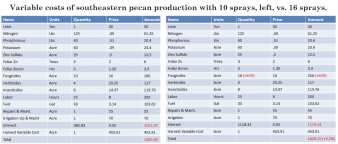
The new cost of pecan production in the Southeast
I recently attended the National Pecan Shellers Association Annual Meeting where New Mexico State Pecan Specialist Richard Heerema and I gave a joint presentation on “The Cost of Pecan Production”. While compiling this information for the southeastern production costs, I was a little surprised at how our costs have gone up only within a couple...
Read more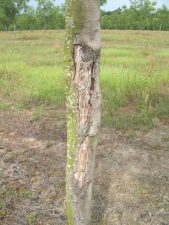
Bot canker on pecan
Young pecan trees are a big investment and we hate to see them get weak, decline, or up and die. I’ve seen a lot of young tree die-back this year. While much of this has been related to cold damage, some trees are feeling the effects of a subtle problem that often goes unnoticed until...
Read moreInclude foliar sulfur sprays in June and July to maximize nut size
An insufficient plant supply of sulfur (S) has been shown to reduce crop productivity, diminish crop quality, affect plant health, and impair N-use efficiency. The effect of N application on plant performance is largely dependent on the S status of the plant and similarly, maximum plant response to S application will occur only when N...
Read moreDon’t over-manage young trees
We’ve seen an incredible number of pecan trees planted over the last few years and at this point, it’s not slowing down. As the planting of pecan trees across the southeastern pecan belt continues this winter, I thought it would be a good time to discuss some of the issues I’ve dealt with over the...
Read moreHow was your foliage this year?
Foliage retention until the first’ frost has always been a goal of pecan producers in order to keep the trees healthy and productive from year to year. It’s been tough to maintain good foliage health this year due to the ravages of scab, anthracnose, downy spot, zonate leaf spot, nutritional imbalances, and most significantly black...
Read moreFungicide Advice With the Return of Scab to South Georgia
Over the last several years we’ve gotten used to winning the battle with pecan scab fairly easily thanks to a multi-year drought; however, that has all changed this year. Not only have we had larger amounts of rainfall, but it has been more frequent, which really presents ideal conditions for the development of pecan scab....
Read moreWhat’s in your tank?
There’s a popular credit card advertisement that asks the question, “What’s in your wallet?” Well, if you’re a pecan farmer, the answer to that question may be less money, unless you’re careful about how you budget your expenses. There’s no question that you have to spend money to grow pecans. But, you can spend a...
Read more‘Same old things’ won’t work in a changing industry
I’ll start this article off by telling you I’m not quite sure where its going. I’ve got a lot that I want to discuss and I’m not sure it will all tie together but I’ll do my best. The year 2012 has been an interesting one for those who grow pecans. It began with an...
Read morePecan anthracnose in the Southeast
In 2011, those of us in the Southeast got to experience what it was like to grow pecans in the desert. Fortunately, we’ve seen more rainfall in the Southeast during 2012 than we saw last year. After all, it wouldn’t take much. While we have been thrilled with each rain we received, rainfall and pecan...
Read more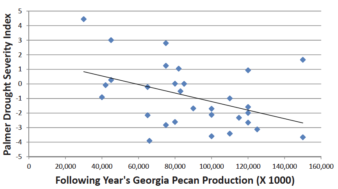
What does the 2011 drought mean for the 2012 crop?
Most of the pecan belt saw extreme to severe drought conditions throughout much of the 2011 growing season. Although here in the Southeast, we saw nothing like the conditions parts of Texas suffered, but we are still extremely dry. Many wells around the region went dry last year and current groundwater levels across the southern...
Read moreEase into new cultivars
The recent booming pecan market has led to a renewal of the pecan industry. Acreage is on the rise and new people are looking to pecans as a crop and as a wise investment. With this, has come a great interest in pecan cultivars, particularly the new ones. I have kept largely silent on this topic...
Read moreClover Benefits Orchard Soil Quality
Orchard soil health is the basis of everything that takes place in the pecan orchard. The bottomland soils on which pecans grow in their native range vary considerably from those on upland sites where the trees are cultivated and grown commercially in the southeastern U.S. The loamy bottomland ridges to which pecans are adapted typically...
Read moreHow Does the Hot, Dry Weather Affect the Crop?
If there was ever a year in Georgia to stretch out fungicide sprays, 2011 has been the year, at least through early June. So far this year, we have learned a little about what its like to grow pecans in the desert. As I write this in early June, we have had 4 days of...
Read morePecan Weed Control Options
Pecan producers are fairly limited in their choice of herbicide options. We have basically three burndown herbicides available for use on pecan. These include glyphosate, paraquat and glufosinate (Rely). Glyphosate is the old standby that has been used for years. When it first came out, glyphosate seemed like a miracle herbicide. Its systemic activity killed...
Read moreWhat’s Georgia Planting?
The Chinese appetite for pecans has placed a spotlight on our crop, which is increasing in popularity. This has led to a pecan acreage increase in Georgia, which from the phone calls and visits I have had, does not appear to be subsiding. Pecan nurseries have been unable to provide enough trees to keep up...
Read moreDon’t Stop Irrigation, Yet
Most growers are aware that the most critical time for adequate irrigation in pecans is during kernel filling from mid-August to mid-September. However, the pecan tree’s demand for water does not end when kernel filling is complete. In general, pecans need about 55-60 inches of water per year. Depending on tree spacing and size, orchards...
Read moreWhat Variety To Plant In The Southeast?
The most common question asked of pecan Extension specialists is “What variety should I plant?”. In the West where you may have primarily only two varieties that are commonly grown, it’s not that tough of a decision. In the Southeast, the variety question has no simple answer because we have a multitude of varieties to...
Read moreGood Agricultural Practices For Pecans
Over the last several years, agriculture has faced many challenges. Among these has been increased scrutiny resulting from various foodborne illnesses in multiple crops. Fortunately for us, pecans have been spared the brunt of this abuse so far. While many feel that food safety and the prevention of contamination are problems that only shellers and...
Read more